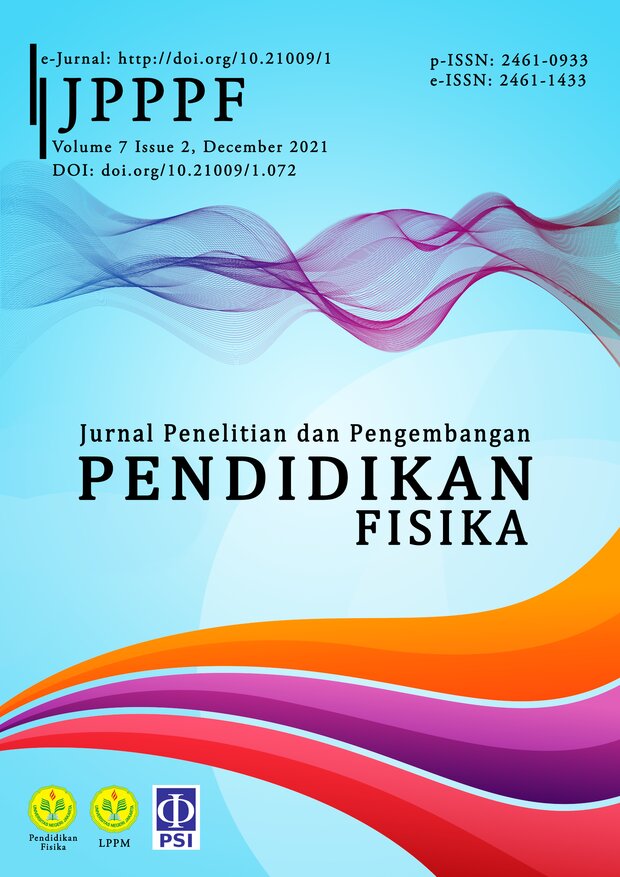Correcting Students’ Understanding about Simple Direct Current (DC) Circuits through Scientific Approach
DOI:
https://doi.org/10.21009/1.07207Keywords:
simple DC circuits, scientific approach, students’ understanding, science learningAbstract
This paper reports the effect of teaching electricity in simple DC circuits using a scientific approach on students’ understanding. The study was a pre-experimental design using 12 students. They were all studying in specific first secondary schools in the sub-urban area in Kasongan City, Katingan Regency, Central Kalimantan Province. This work used the multiple-choice tests to combine reasoning and certainty of response index (CRI). This test was used as pre and post-test, respectively, to assess students’ understanding of electricity in simple DC circuits. As a result, it is found that the secondary students have alternate conceptions about simple DC circuits, such as “electricity comes out of both ends of a cell” and “a circuit uses up the electric current”. On the other hand, the results of this study showed that the use of a scientific approach in learning could help students achieve conceptual change about electricity in simple DC circuits. The findings from the study suggested that there was a difference in students’ understanding of simple DC circuits between pre-test and post-test. The scientific approach to learning seemed to help students achieve conceptual change about electricity in simple DC circuits.
References
Akcay, H & Yager, RE 2016, ‘Students Learning to Use the Skills Used by Practicing Scientists’, Eurasia Journal of Mathematics, Science & Technology Education, vol. 12, no. 3, pp. 513-525.
Anita, A, Assagaf, SLH & Boisandi, B 2018, ‘The Understanding of Pre-Service Physics Teachers on Electric Circuit Concept’, Jurnal Penelitian & Pengembangan Pendidikan Fisika, vol. 4, no. 2, pp. 125-130.
Black, PJ & Lucas, AM 2002, ‘Children’s informal ideas in sciences’, Routledge, London, UK.
Chairam, S, Klahan, N & Coll, RK 2015, ‘Exploring Secondary Students' Understanding of Chemical Kinetics through Inquiry Based Learning Activities’, Eurasia Journal of Mathematics, Science & Technology Education, vol. 11, no. 5, pp. 937-956.
Emden, M 2021, ‘Reintroducing “the” Scientific Method to Introduce Scientific Inquiry in Schools?’, Sci & Educ, vol. 30, pp. 1037-1073.
Glauert, EB 2009, ‘How young children understand electric circuits: prediction, explanation, and explorations’, International Journal of Science Education, vol. 31, no. 8, pp. 1025-1047.
Hakim, A, Liliasari & Kadarohman, A 2012, ‘Student Concept Understanding of Natural Products Chemistry in Primary and Secondary Metabolites Using the Data Collecting Technique of Modified CRI’, International Online Journal of Educational Sciences, vol. 4, no. 3, pp. 544-553.
Hammerich, PL 2002, ‘Confronting Students’ Conceptions of the Nature of Science with Cooperative Controversy’, in William F. McComas (ed.), The Nature of Science in Science Education Rationales and Strategies, Kluwer Academic Publishers, USA.
Handayani, SL 2021, ‘Comparison of Basic Science Process Skills for Students on Electrical Materials with the Rasch Model Analysis’, Jurnal Penelitian & Pengembangan Pendidikan Fisika, vol. 7, no. 1, pp. 73-82.
Hartanto, TJ & Nawir, M 2017, ‘Studi tentang Miskonsepsi Siswa dan Mahasiswa terhadap Konsep Rangkaian Listrik Arus Searah (Direct Current)’, Vidya Karya, vol. 32, no. 2, pp. 97-109.
Hartanto, TJ, Sinulingga, P & Suhartono 2015, ‘Analisis Pemahaman Konsep IPA (Fisika) Siswa SMP di Kota Palangka Raya’, Prosiding Seminar Nasional Fisika Universitas Palangka Raya, Universitas Palangka Raya, pp. 115-123.
Hasni, A & Potvin, P 2015, ‘Student’s interest in science and technology and its relationships with teaching methods, family context and self-efficacy’, International Journal of Environmental and Science Education, vol. 10, no. 3, pp. 337-366.
Karamustafaoglu, S & Naaman, RM 2015, ‘Understanding Electrochemistry Concepts using the Predict-ObserveExplain Strategy’, Eurasia Journal of Mathematics, Science & Technology Education, vol. 11, no. 5, pp. 923-936.
Kucukozer, H & Demirci, N 2008, ‘Pre-Service and In-Service Physics Teachers’ Ideas about Simple Electric Circuits’, Eurasia Journal of Mathematics, Science & Technology Education, vol. 4, no. 3, pp. 303-311.
McFarlane, DA 2013, ‘Understanding the challenges of science education in the 21st century: New opportunities for scientific literacy’, International Letters of Social and Humanistic Sciences, vol. 4, pp. 35-44.
Posner, GJ, Strike, KA, Hewson, PW & Gertzog, WA 1982, ‘Accommodation of a scientific conception: Toward a theory of conceptual change’, Science Education, vol. 66, pp. 211–227.
Prabowo, SA 2015, ‘The Efectiveness of Scientific Based Learning Towards Science Process Skill Mastery of PGSD Students’, Indonesian Journal of Science Education, vol. 4, no. 1, pp. 15-19.
Preston, CM 2019, ‘Effect of a Diagram on Primary Students’ Understanding About Electric Circuits’, Res Sci Educ, vol. 49, pp. 1433-1456.
Rahmawati, A, Nisfah, NL & Kusairi, S 2019, ‘The Capability Analysis of High Order Thinking Skills (HOTS) on Dynamic Electricity Material in Junior High School’, Jurnal Penelitian & Pengembangan Pendidikan Fisika, vol. 5, no, 2, pp. 163-168.
Sanjaya, W 2011, ‘Perencanaan dan Desain Sistem Pembelajaran’, Kencana Prenada Media Group, Jakarta, Indonesia.
Shipstone 1984, ‘A study of children’s understanding of electricity in simple DC circuits’, European Journal of Science Education, vol. 6, no. 2, pp. 185-198.
Suparno, P 2007, ‘Metodologi Pembelajaran Fisika: Konstruktivistik dan Menyenangkan’, Universitas Sanata Dharma Press, Yogyakarta, Indonesia.
Triyuni 2016, ‘The influence of science learning set using scientific approach and problem solving model on learning outcomes of junior high school students in the subject of heat and temperature’, Indonesian Journal of Science Education, vol. 5, no. 2, pp. 177-185.
Tsai, CH, Chen, HY, Chou, CY & Lain, KD 2007, ‘Current as the Key Concept of Taiwanese Students' Understandings of Electric Circuits’, International Journal of Science Education, vol. 29, no. 4, pp. 483-496.











